Physical Address
304 North Cardinal St.
Dorchester Center, MA 02124
Plantar heel pain is a common disease process that continues to challenge orthopaedic surgeons. Because of the complex anatomy around the heel and the plantar surface of the foot, the function and etiology of pain have been difficult to understand.
Early examiners suggested an infectious origin for heel pain. In the 1930s, they proposed that tuberculosis, streptococcal, gonorrhea, and syphilis infections caused heel pain. Dedicated research refuted the infectious etiology of heel pain, and efforts were made to find a mechanical source. With the evolution of x-ray technology, emphasis placed on the heel spur as the source of heel pain gained momentum. Steindler and Smith (1938) performed rotational osteotomies to move the spur away from the weight-bearing surface. In 1957, DuVries categorized the different morphology of calcaneal spurs and their impact on heel pain. More recent cadaveric studies demonstrated the location of the spur within the flexor digitorum brevis (FDB), abductor hallucis (AH), and abductor digiti minimi (ADM) musculature in many cases, rather than exclusively within the plantar fascia itself ( Fig. 12-1 ). In the 1960s, this same interest in heel anatomy led to consideration of nerve entrapment as a cause of heel pain ( Fig. 12-2 ). Tanz discovered that a branch of the lateral plantar nerve passes around the medial border of the heel and innervates the abductor digiti minimi muscle. Baxter and Thigpen later elaborated on this and demonstrated how the first branch of the lateral plantar nerve (FBLPN) can become entrapped, resulting in plantar heel pain. These early concepts and research laid the foundation of our current understanding of the anatomy, mechanisms, and causes of plantar heel pain.
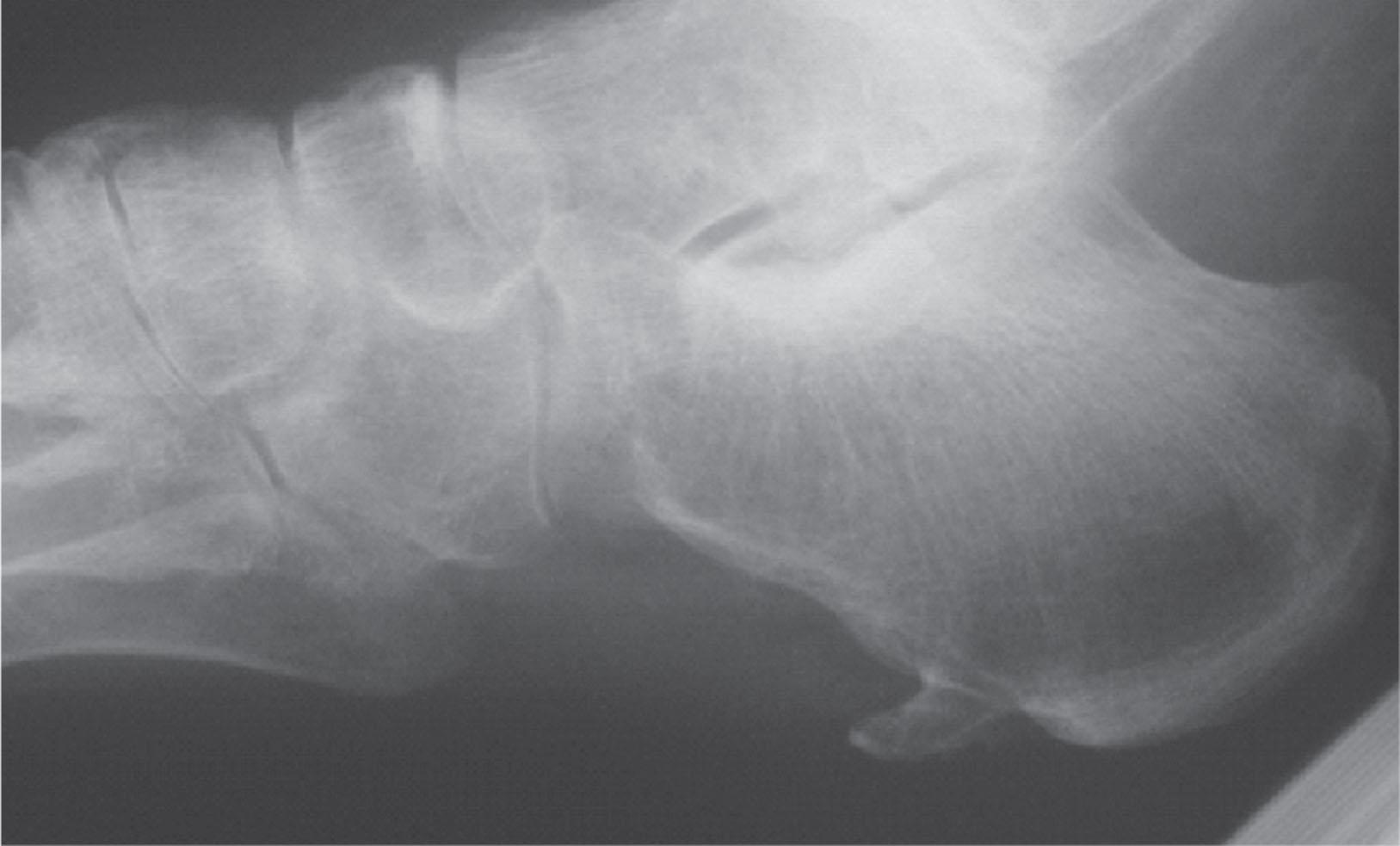
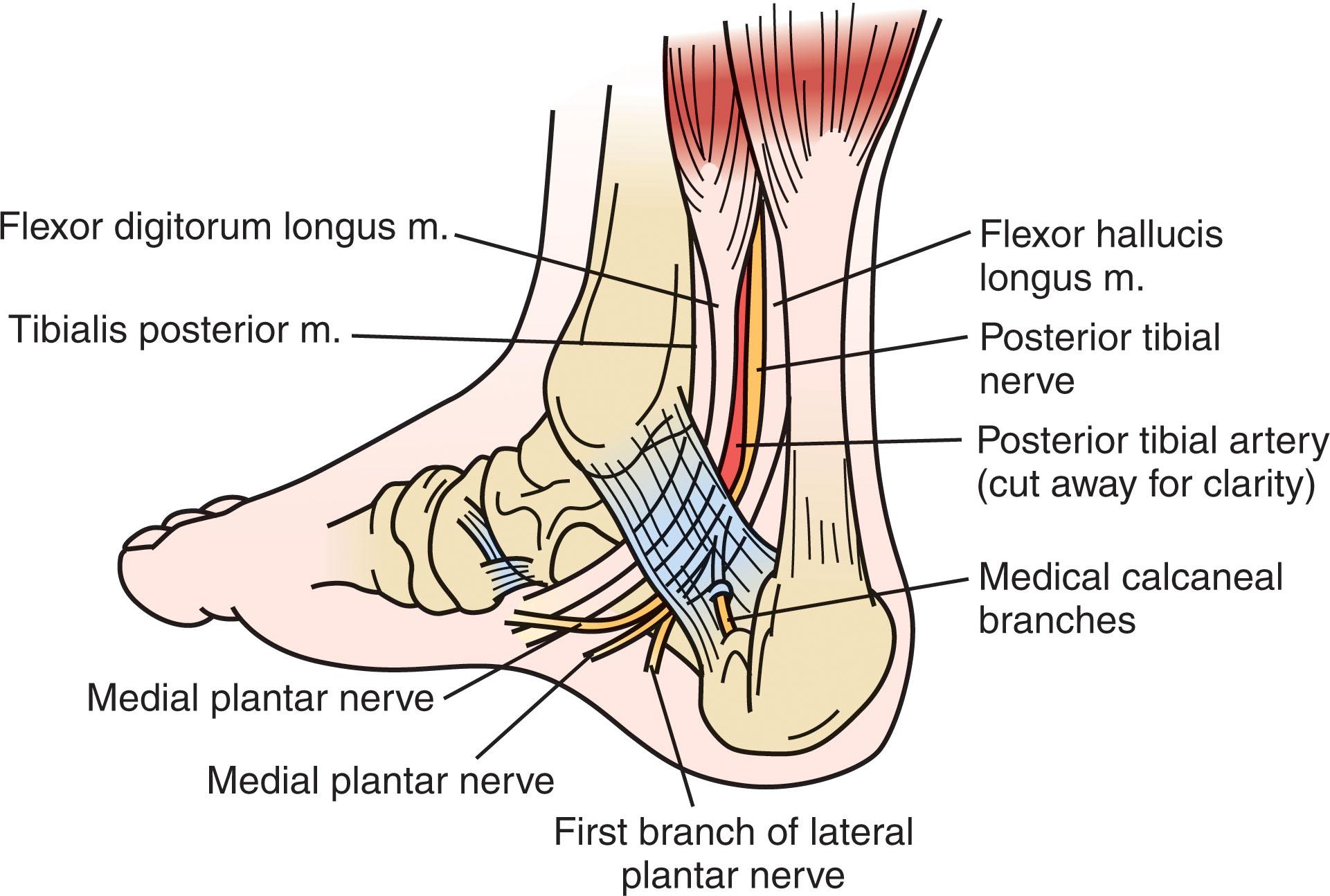
Population studies suggest that the prevalence of plantar heel pain ranges from 1% to 10% “in the past month” in adults. These numbers trend upwards with age and certain activity and may be as high as 20% in runners, laborers, and military service members. This leads to 1 to 2 million visits to physicians annually for heel pain in the United States, with estimations that heel pain is the cause of 1% of all orthopaedic visits. In addition to age and profession, increased rates of plantar heel pain are seen in patients with decreased dorsiflexion at the ankle and body mass index (BMI) >30 kg/m 2 . This can be a challenging pathology to manage, with one long-term study demonstrating only 55% of patients experiencing complete resolution at 10 years and symptom duration averaging nearly 2 years in those that did improve. These studies demonstrate not only the significant number of patients impacted but also the wide range of ages within the adult population affected by plantar heel pain.
The plantar fascia is composed of bands of fibrous tissue that originate on the anteromedial aspect of the calcaneal tuberosity and insert on the bases of the proximal phalanges. Strong vertical septa divide the medial, central, and lateral portions of the plantar fascia and create three distinct compartments of intrinsic plantar muscles. The three bands of fascia spread into a broad sheet as they course distally and divide into five digital bands at the metatarsophalangeal (MTP) joints ( Fig. 12-3 ). Each digital band divides to pass on either side of the flexor tendons and inserts into the periosteum of the base of the proximal phalanges. There is some variability in the fascia and its relationship to neurovascular structures, which continues to be an area of anatomic study. Fibers of the plantar fascia also blend with the dermis, transverse metatarsal ligament, and flexor tendon sheath. As the plantar fascia courses distally from its origin deep to the plantar fat pad of the heel, it becomes subcutaneous and is easily palpated beneath the longitudinal arch along the plantar aspect of the foot.
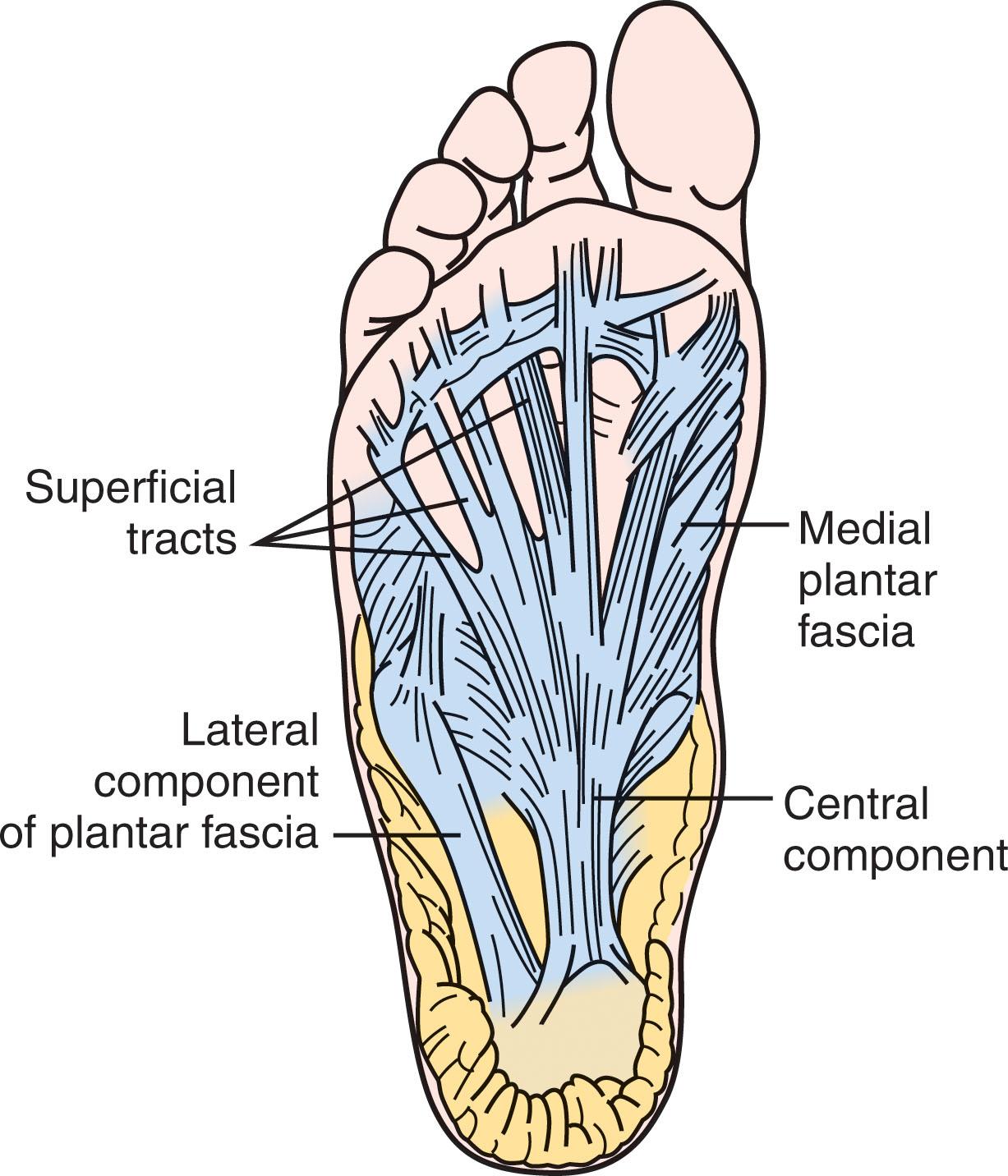
The plantar fascia is relatively inelastic. Postmortem studies found a maximum elongation of 4%, with failures in the tissue occurring at 90 kg of force at the clamp margins. The fascia itself requires more than 1000 N to fail. Tension along the plantar fascia develops when the toes dorsiflex during the stance phase of gait, which transmits tensile loads to its calcaneal origin. The transmission of this tensile load elevates the longitudinal arch and slightly inverts the heel, which is referred to as the windlass mechanism. Because of its inelastic properties, high tensile forces are concentrated on the origin of the plantar fascia during the push-off phase of gait, as the MTP joints dorsiflex via the windlass mechanism. In addition, the gastrocnemius-soleus complex pulls simultaneously and concentrates additional body weight onto the forefoot while the downward acceleration of the body concentrates an additional 20% increase in the ground reaction forces. Repetitive activation of the windlass mechanism, as one might see in runners or standing workers, may result in tensile overload, microtears, inflammation, and chronic degenerative changes in the plantar fascia origin.
The anatomy of the heel fat pad was first described by Tietze in 1921. The structure is a honeycombed pattern of fibroelastic septa that completely enclose fat globules ( Fig. 12-4 ). The closed-cell structure of the fat pad provides the mechanical integrity for its shock-absorbing function. The tissue septa are U-shaped around the tuberosity and anchored to the calcaneus and skin. Elastic transverse and diagonal fibers that separate the fat into compartments reinforce the chambers internally. The fat pad on the calcaneus averages 1.5 cm in thickness and functions as an important cushion to the hindfoot. A typical healthy man has a gait velocity of approximately 82 m/min and a cadence of 116 gait cycles/min. Each heel strike generates 110% of body weight but can concentrate up to 250% of body weight with running. After approximately age 40 years, the fat pad begins to deteriorate; with the loss of collagen, elastic tissue, and water, the overall thickness and height of the fat pad decreases. These changes result in softening and thinning of the heel fat pad, decreased shock absorbency, and reduced protection of the heel tuberosity. More recently, anatomic analysis via imaging and 3D modeling has provided further detail on heel pad structure and senescence.

Heel pain can result from mechanical-related changes, spondyloarthropathies, or neurogenic conditions. Mechanical derangements cause classic proximal plantar fasciitis, distal plantar fasciitis, plantar fascia ruptures, and stress fractures of the calcaneus. Rheumatologic conditions cause a wide variety of presentations of pain around the heel. Finally, neurologic conditions from impingement of critical nerves about the foot and ankle cause substantial pain in the heel.
Although heel spurs can occur with heel pain, they are not considered the cause. Approximately 50% of patients with heel pain have heel spurs. Shmokler et al found a 13.2% incidence of heel spurs in 1000 patients chosen randomly, and only 5.2% of the total patients with heel spurs reported any history of heel pain. Williams et al found that 75% of patients who had heel pain also had spurs, compared with 63% of patients who had no heel pain.
From a histologic perspective, plantar fasciitis is characterized by a myxoid degenerative process, with microtearing and fragmentation of the fascia. This may be better described as a “fasciosis” as the process generally lacks an inflammatory presentation, aside from patients with inflammatory arthropathies.
The role of fat pad thickness is unclear, with varying reports demonstrating heel pain with thickened or diminished heel pads. Fat pad elasticity may play a stronger role and has been correlated with heel pain. Evidence suggests a decrease in elasticity (i.e., increased stiffness) associated with increased age and BMI. Uncommonly, the heel pad can be destabilized in the setting of high energy trauma.
Contracture or tightness of the posterior musculature likely plays a mechanical role in plantar heel pain, as well as myriad other foot pathology. Differentiation of isolated gastrocnemius contracture from the entire gastrocnemius-soleus complex can be identified via the Silfverskiӧld test. Contracture is generally defined as the inability to dorsiflex past neutral ankle position with the Chopart joints reduced and stabilized. Posterior contracture is present in roughly 80% of patients with plantar fasciitis, compared to 20% in the general population. Recent studies strongly correlate increasing degrees of tightness to higher levels of heel pain.
Neurogenic causes are often related to tarsal tunnel syndrome (TTS) and may present independently or coexist with plantar fasciitis or other etiologies. TTS can be divided into proximal and distal TTS. Proximal TTS involves a compression neuropathy of the tibial nerve under the flexor retinaculum, while distal TTS involves compression to one or more of the terminal branches of the tibial nerve. Distal TTS frequently includes the abductor hallucis muscle’s deep fascia as a source of compression. Compression of the first branch of the lateral plantar nerve (or “Baxter’s Nerve”) is believed to be the most common neural cause of plantar heel pain. Entrapment of the nerve most frequently takes place between the deep fascia of the abductor hallucis and the medial border of the plantar fascia. At this location, the nerve courses from a vertical structure to a more horizontal position as it passes around the medial border of the calcaneus.
Lumbar radicular pain can be a source of neurologic heel pain, especially in the distribution of S1. This pain frequently lacks localized tenderness on the plantar heel and seldom demonstrates the characteristic start-up pain associated with plantar fasciitis.
Systemic involvement should be considered in patients with bilateral, recalcitrant heel pain, younger patients, and those who have heel pain with concurrent pain in multiple joints. Some studies of heel pain have demonstrated an underlying systemic condition in up to 16% of patients. Gerster’s study of 150 patients with a seronegative spondyloarthropathy found 22% suffered from plantar fasciitis or Achilles tendinitis, and 91% of these patients tested positive for human leukocyte antigen-B27 (HLA-B27). When comparing this group with 220 patients having rheumatoid arthritis, Gerster rarely found plantar fasciitis in the rheumatoid arthritis group. Other conditions to consider include systemic lupus erythematosus, psoriasis, inflammatory bowel diseases, ankylosing spondylitis, Reiter’s syndrome, Behçet’s syndrome, and others.
A thorough history and physical examination will most often guide the clinician to the appropriate diagnosis and treatment plan. The differential diagnosis for plantar heel pain includes proximal plantar fasciitis, nerve entrapment, calcaneal stress fractures, disorders of the fat pad, midplantar fascia strain or rupture, inflammatory arthropathy, plantar fibromatosis, flexor hallucis tendinitis, tumors, and infections ( Box 12-1 ).
Proximal plantar fasciitis
Acute plantar fascia rupture
Entrapment of the FBLPN
Plantar fasciitis with entrapment of the FBLPN
Midplantar fascia strain
Calcaneal stress fracture
Central heel pain syndrome
Enthesitis: spondyloarthropathies
Tarsal tunnel syndrome
Plantar fibromatosis
Flexor hallucis longus tendonitis
Subcalcaneal bursitis
S1 radiculopathy
With the most common presentation, proximal plantar fasciitis, patients usually complain of heel pain that is most notable upon the first steps in the morning or after sitting/resting for an extended period of time. The pain starts with a sharp shooting quality that tends to change to an ache with continued ambulation. Having patients point to the location of their greatest area of pain can be helpful. Usually, they will point to the origin of the medial longitudinal arch at the medial tubercle of the calcaneus ( Fig. 12-5 ).
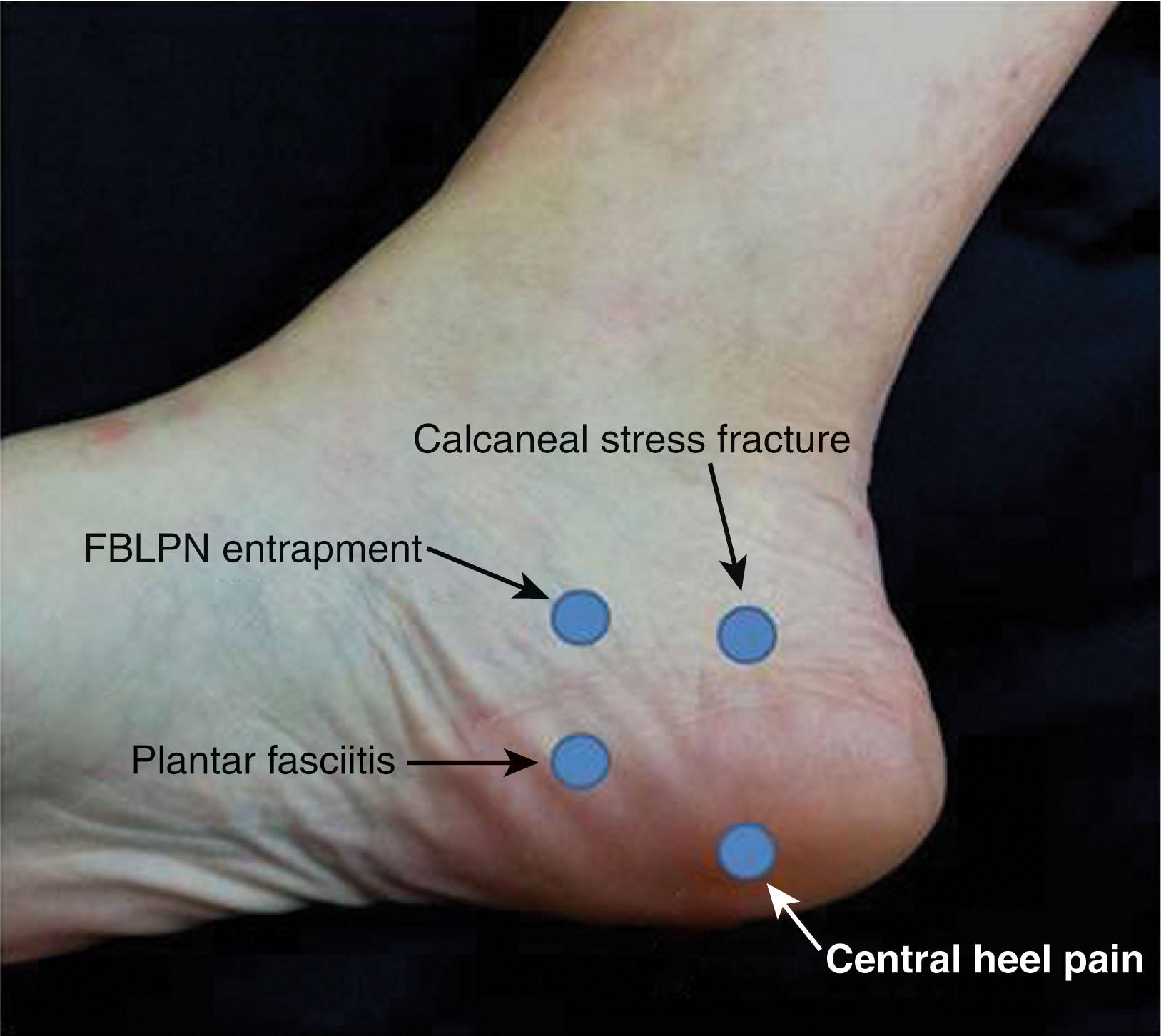
Clinicians should next review the patient’s general health, including a treatment history for the heel pain (e.g., therapy, medications, injections, orthoses, or surgeries). Polyarthralgia or constitutional symptoms, such as weight loss, fevers, or chills, should lead the clinician to investigate for a systemic condition. Further questioning should focus on the timing of the pain and patient’s activities, both recreational and occupational. Specifically, one should inquire about a change in weight or activity coincident with the onset of symptoms. In addition, the amount of time spent weight bearing throughout the day is a causative and provocative factor.
Athletes who perform running and jumping activities are particularly prone to plantar heel pain. This can also commonly be seen with an increase or initiation of a treadmill exercise routine, vigorous hiking, or any activity that particularly loads the “ball of the foot.” It is important to differentiate pain during heel strike versus pain with push off. In addition, pain at the onset of physical activity can differ from pain occurring during activity or after activity. Pain occurring after an acute injury is more likely a plantar fascia rupture or acute fracture within the hindfoot. Rupture is often described as a “tearing” sensation. Patients with ruptures of the plantar fascia often have a history of corticosteroid injection and previous plantar fasciitis symptoms. Paradoxically, these patients can have less pain after rupture of the plantar fascia, although there can be a subtle collapse of the longitudinal arch. Ruptures in athletes tend to occur during running but can present during tennis, soccer, and basketball. Additionally, calcaneal stress fractures must be considered and evaluated in the patient presenting with plantar heel pain. The patient may describe a significant increase in activity level or training regimen. Early on their heel pain can easily be confused with plantar fasciitis. Eventually, the pain is present throughout the day and continues to increase in intensity during weight bearing.
With either proximal or distal TTS, patients complain of a burning or tingling element with their plantar heel pain. These symptoms can usually be reproduced by percussion over the distal course of the tibial nerve within the confines of the tarsal tunnel. These may radiate more distally into the foot along the tibial nerve distribution. Patients may additionally describe radicular symptoms radiating up the leg in the setting of spinal etiology. These symptoms do not always follow the “first steps in the morning” pattern.
Unrelenting pain at rest or night pain is a red flag that the pain may be related to a tumor or an infectious process. Bilateral heel pain, especially in a younger patient, suggests a systemic process, such as ankylosing spondylitis, Reiter syndrome, or other spondyloarthropathy. A neuritic, dysesthetic type of pain is likely caused by nerve compression and irritation that can occur at rest. Associated radiculopathy or spinal symptoms may also suggest neurogenic etiology.
Clinicians should perform a comprehensive physical examination of the foot and ankle in search of the primary source of pain, concomitant disorder, or a locus of referred pain. A pes planus or a cavus foot deformity may be a causative or contributing factor. Assess gastrocnemius-soleus tightness. A standing evaluation of hindfoot alignment should be performed. Examining the spine and extremities can help to elucidate any neurologic component to the pain; radiculopathy in an L5-S1 distribution could explain plantar heel pain.
Tenderness at the plantar medial heel that is exacerbated by concomitant passive dorsiflexion of the ankle and toes is due to the increased tension placed on the origin of the plantar fascia. Continued palpation distally will usually confirm the presence of a tight fascial band or assist with diagnosing a partial attenuation or rupture. Pain and tenderness confined to the middle portion of the fascial band and well distal to the origin of the plantar fascia is referred to as midplantar fascia strain by the authors.
A plantar fascia rupture diagnosis can be made based on physical examination findings, along with the patient’s description of the injury. Clinical findings include the inability to perform a single-stance heel raise, pain with MTP extension, and focal plantar medial ecchymosis ( Fig. 12-6 ). Although some reports describe high rates of return to activity and complete resolution of pain, other authors report a 50% rate of chronic pain and activity restriction postinjury. Examination findings of a calcaneal stress fracture include a reproduction of pain with the calcaneal squeeze test (a medial-lateral compression of the calcaneal tuberosity, Fig. 12-7 ) along with associated swelling. Confirmation of the diagnosis is usually made with plain radiographs 2 to 3 weeks after the onset of symptoms or with an MRI scan.

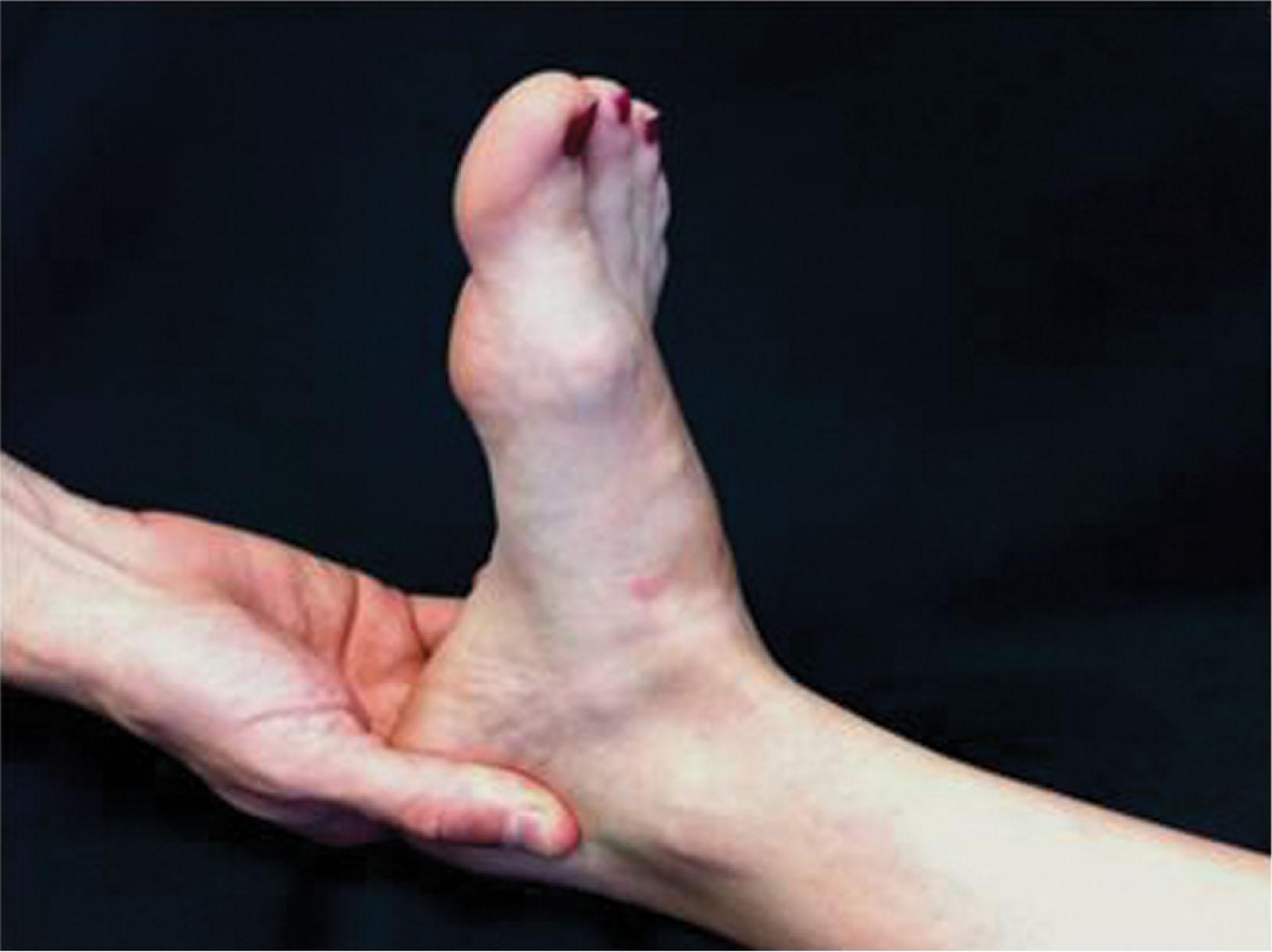
Neurologic exam includes sensory exam to light touch and Tinel’s test with percussion over the tarsal tunnel. Baxter’s nerve tenderness may present slightly dorsal to the usual plantar fascial origin. Denervation of the abductor digiti minimi may cause inability to abduct the small toe, and this can be evaluated in comparison to the normal contralateral side. An additional physical examination finding includes a pain with the “dorisflexion-eversion test” (dorsiflexion and eversion of the ankle in combination with full extension of the MTP joints). The “windlass test” (full extension of all the MTP joints, Fig. 12-8 ) also results in increased strain across the tibial nerve and plantar fascia, rendering both tests unreliable in determining whether plantar fasciitis or TTS is the etiology of a patient’s plantar heel pain.
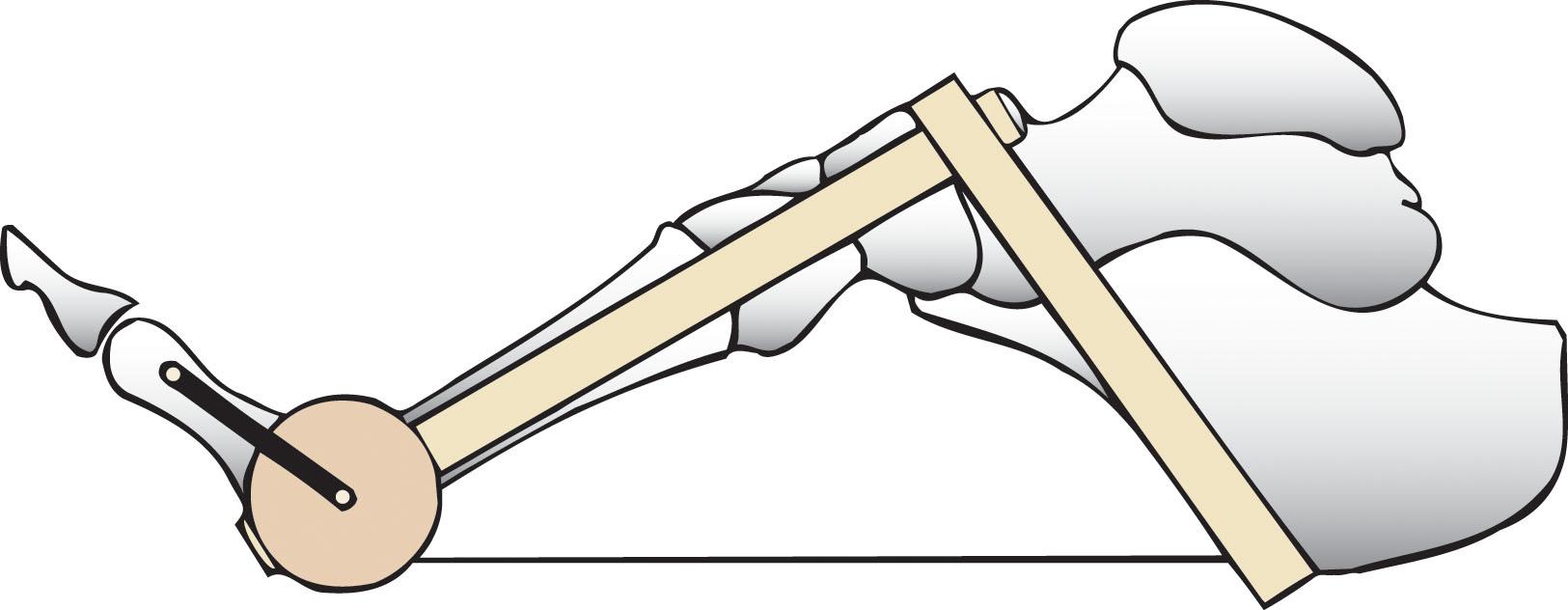
Plantar fibromatosis causes pain over the midportion of the fascia; the clinician can palpate nodules within the fascial substance. Flexor hallucis longus tendinitis at the level of the master knot of Henry can manifest as plantar heel pain. Tenderness with resisted flexion of the great toe can differentiate this condition from other etiologies.
Central heel pain syndrome (or calcaneal fat pad atrophy) presents with a more central and proximal location of pain than the plantar fascia’s origin. Palpation of the fat pad reveals a softened and flattened surface, with central tenderness. Erythema and inflammation can occur over the plantar aspect of the heel, a finding unique to this condition. The fat pad may be unstable from the underlying calcaneal tuberosity, with a concomitant bursitic reaction between the bone and the pad.
Diagnostic modalities such as radiographs, bone scans, ultrasound, or magnetic resonance imaging (MRI) are not usually necessary for the diagnosis or treatment of plantar fasciitis. However, they can be useful to exclude other mechanical causes of plantar heel pain. Weight-bearing foot radiographs are obtained to rule out calcaneal stress fracture or hindfoot degenerative joint disease, as well as evaluate structural foot alignment. Consideration can be given to obtaining both foot and ankle films in patients with previous trauma to determine if external sources such as exostosis are contributing to the patient’s symptoms. Computed tomography may also have a limited role in the patient with a prior history of trauma. Technetium bone scans have poor specificity and are rarely helpful in these patients. MRI is sensitive for detecting fascial ruptures, along with confirming the diagnosis of plantar fasciitis; it is most helpful in detecting space-occupying lesions of the tarsal tunnel and subtle calcaneal stress fractures or stress reactions ( Figs. 12-9 and 12-10 ). Ultrasonography has also been used and is thought to be as reliable as MRI for the diagnosis of plantar fasciitis, but it is operator dependent and not as helpful with other pathologic sources of heel pain.
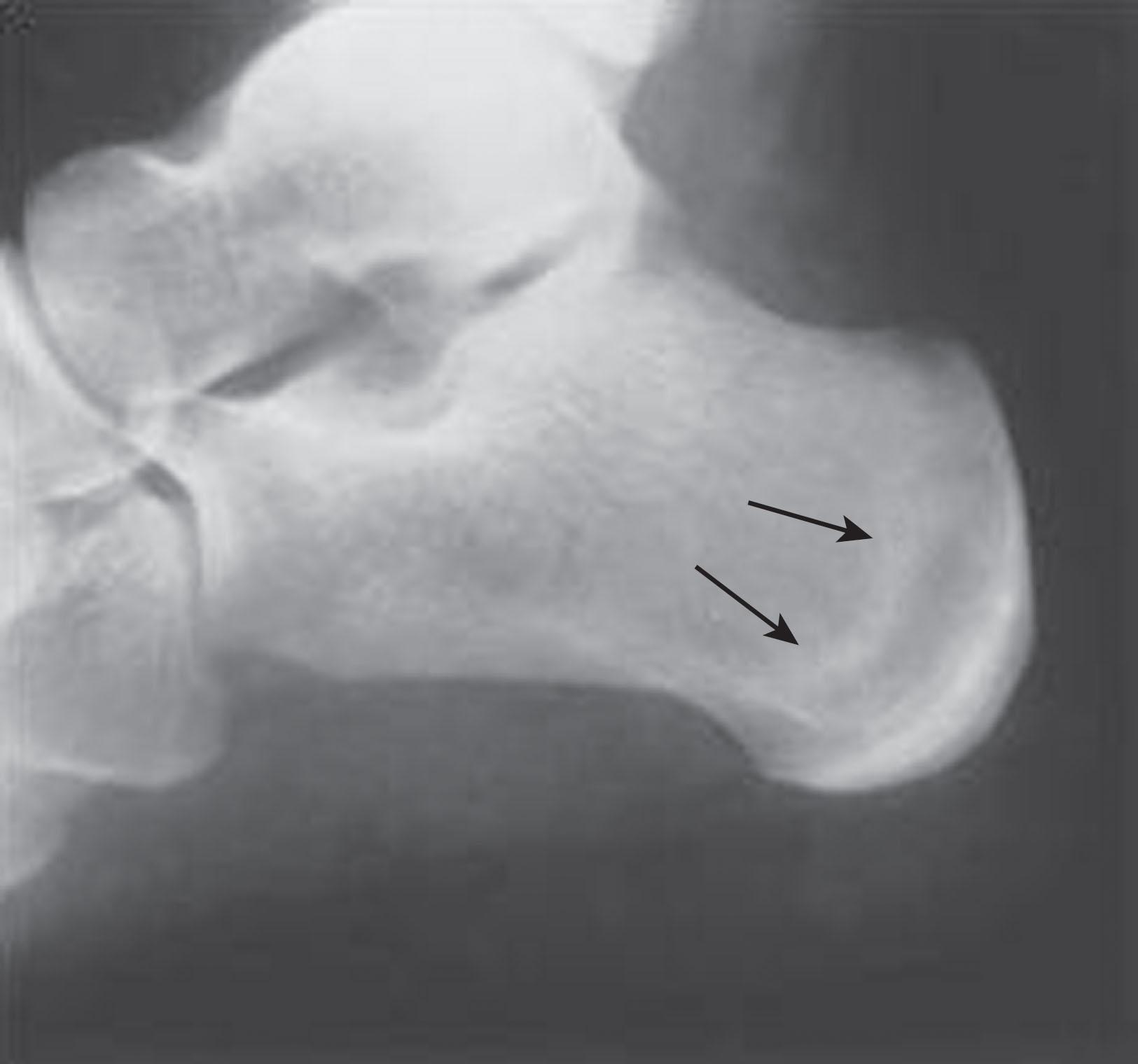
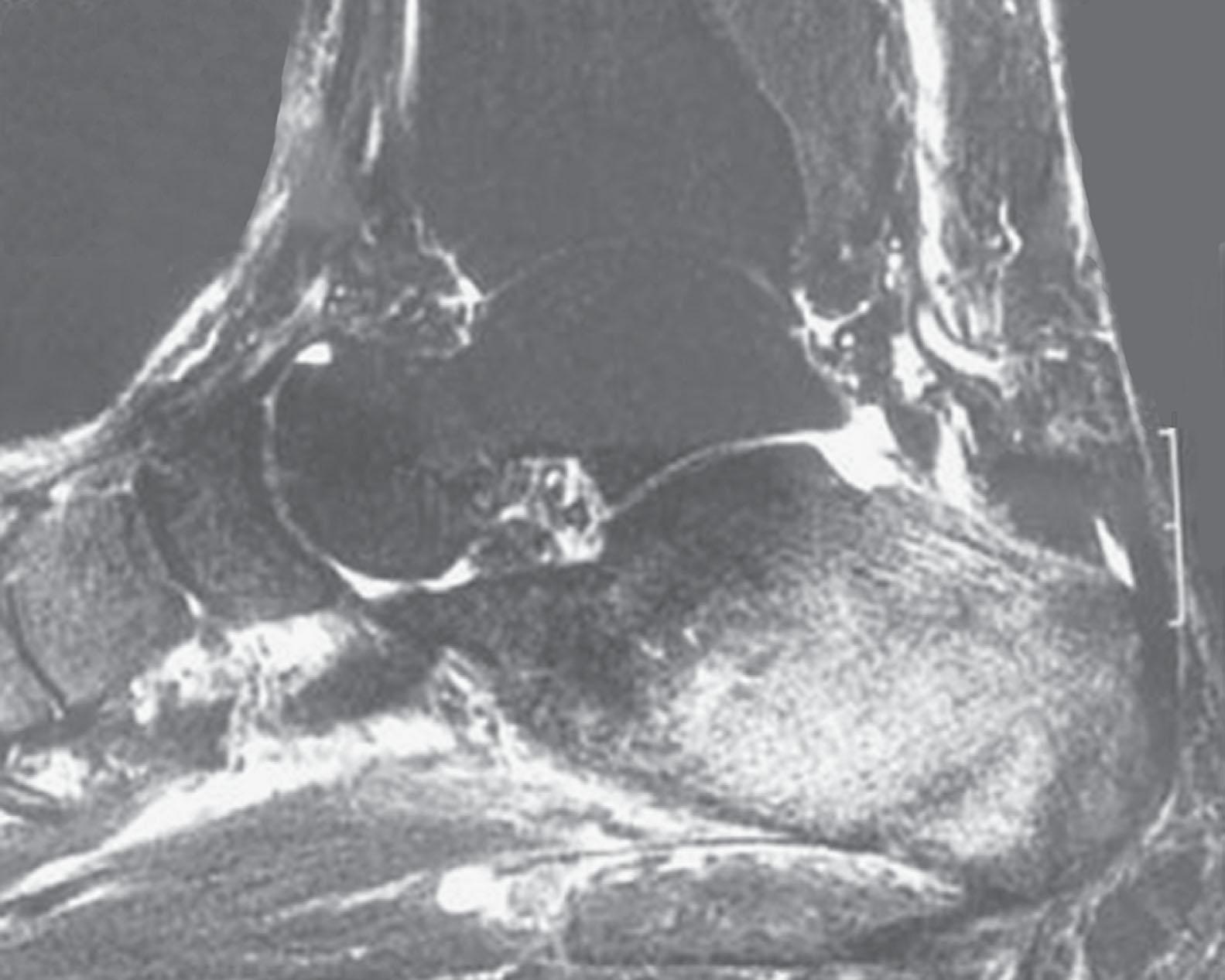
In the setting of a neural component to the patient’s heel pain, electrodiagnostic studies can be performed to assist with ruling out associated pathology, such as radiculopathies and generalized peripheral neuropathy. Electromyographic results for the abductor hallucis or abductor digiti minimi are more likely to be abnormal in the setting of medial or lateral plantar nerve impingement than nerve conduction studies. Although a positive result adds confirmation to the clinician’s diagnosis, a negative result does not rule out the diagnosis of nerve compression because these studies have an accuracy of 90%. Because the neuritic component is believed to be a traction neuropathy most evident in dynamic situations, it is difficult to test with electrodiagnostic studies.
Many inflammatory conditions and spondyloarthropathies can present with heel pain and positive findings on MRI, indicative of an inflammatory process of the plantar heel. Patients with recalcitrant unilateral or bilateral heel pain might suffer from rheumatoid arthritis, systemic lupus erythematosus, psoriasis, inflammatory bowel diseases, ankylosing spondylitis, Reiter’s syndrome, Behçet’s syndrome, or others. Although 20% to 30% of patients can experience bilateral plantar fasciitis, clinicians should consider laboratory testing in patients with bilateral heel pain with simultaneous onset or recalcitrant heel pain. Useful studies include complete blood count, c-reactive protein (CRP), erythrocyte sedimentation rate (ESR), rheumatoid factor, HLA-B27, antinuclear antibodies, cyclic citrullinated protein, and uric acid. Elevated markers may warrant consultation with a rheumatologist.
The overwhelming majority of patients with mechanical heel pain will respond favorably to nonoperative treatment. In plantar fasciitis, 6 to 10 months of treatment with conservative modalities results in a successful outcome for up to 90% of patients, with at least 6 months of nonoperative management accepted as the standard of care by the AOFAS. The efforts of nonoperative treatment are directed toward a reduction in pain, improved function, and shortened duration of symptoms. Although the number of different treatment options for plantar fasciitis are numerous, there are level I and II evidence studies available to assist in choosing the appropriate therapy.
Isolated Achilles stretching was the primary objective of treatment for many years. There is evidence to show that 83% of patients with plantar fasciitis have an equinus contracture in either acute or chronic cases, making Achilles stretching a logical treatment choice.
More recent level I and II evidence, as well as basic science studies, outlines a plantar fascia–specific stretch (PFSS) protocol that has provided significantly better patient outcomes. As reported by DiGiovanni et al in 2003, the PFSS exercise involves maintaining passive ankle and toe dorsiflexion position with palpation and massage of the taut bands of the plantar fascia on stretch ( Fig. 12-11 ). Over a period of 8 weeks, PFSS was compared with Achilles stretching in 101 patients with plantar fasciitis of at least 10 months duration in a randomized controlled trial. Statistically significant improvements were found in pain, activity limitation, and patient satisfaction in the PFSS group when compared with the Achilles group, which was maintained in a subsequent 2-year follow-up study. For most patients, maximal improvement was reached within 6 months of receiving treatment, with only 16 (24%) of 66 patients seeking additional intervention later. The importance and value of plantar fascia-specific stretching has been corroborated by other authors, with some additional benefits of formal outpatient therapy compared to a home plan. The biomechanical impact of the PFSS was later supported by the Flanigan et al cadaveric study, which investigated the foot and ankle position resulting in the greatest amount of stretch placed on the plantar fascia. Fifteen different configurations were used, with combined ankle and toe dorsiflexion producing the maximum stretch. In addition, Cheng et al evaluated plantar fascia mechanics using finite element analysis and demonstrated that toe dorsiflexion has a larger impact on plantar fascia strain than an Achilles tendon dorsiflexion force by a ratio of approximately 2 : 1. These studies assist in supporting the clinical results as well as the logic of treating patients with PFSS versus Achilles stretching alone.
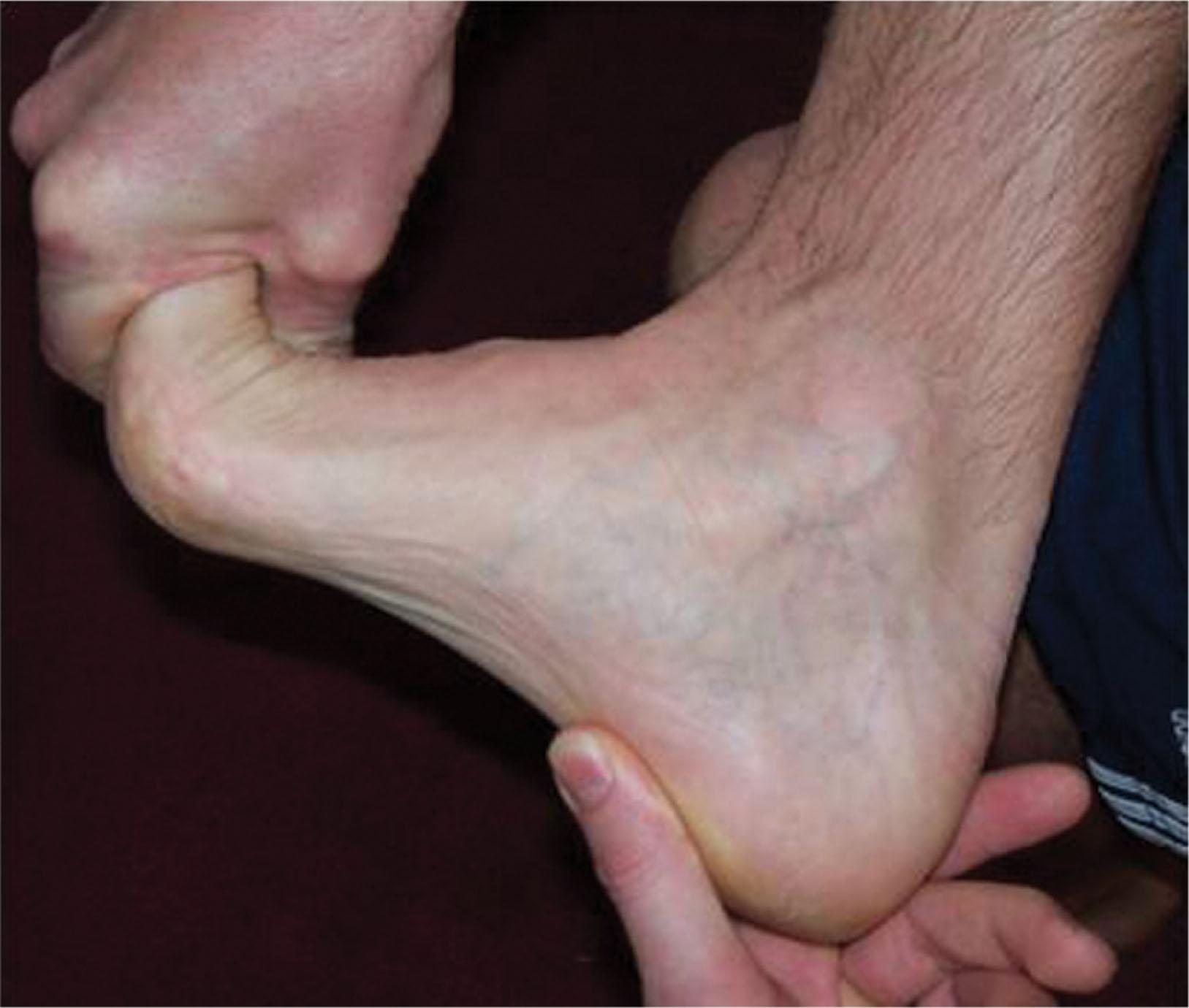
Night splints keep the ankle and foot in a dorsiflexed position ( Fig. 12-12 ). They assist with preventing the plantar fascia from contracting during sleep, resulting in less acute stretch being initially placed on the fascia with the patient’s first steps in the morning. Outcomes of night splint usage are mixed. Berlet et al found 75% of patients reported improvement after 1 month of use in 12 patients with recalcitrant plantar fasciitis. A level II evidence prospective crossover study of 37 patients with recalcitrant plantar fasciitis treated solely with night splints found 80% of participants had subjective improvement of statistical significance in the AOFAS Ankle Hindfoot Rating System and Mayo Clinical Scoring System scores during the period of splint use. Difficulties with the use of night splints include cost, compliance, and negative impact on the patient’s sleeping habits. Roos et al, in a randomized trial comparing the use of night splints to orthotics for the management of plantar fasciitis, showed poorer outcomes in those patients randomized to the night splint arm of the study. Patient compliance was cited as the primary reason for inferior results, with just 1 of 28 patients tolerating the splints for the entire 1-year study period.
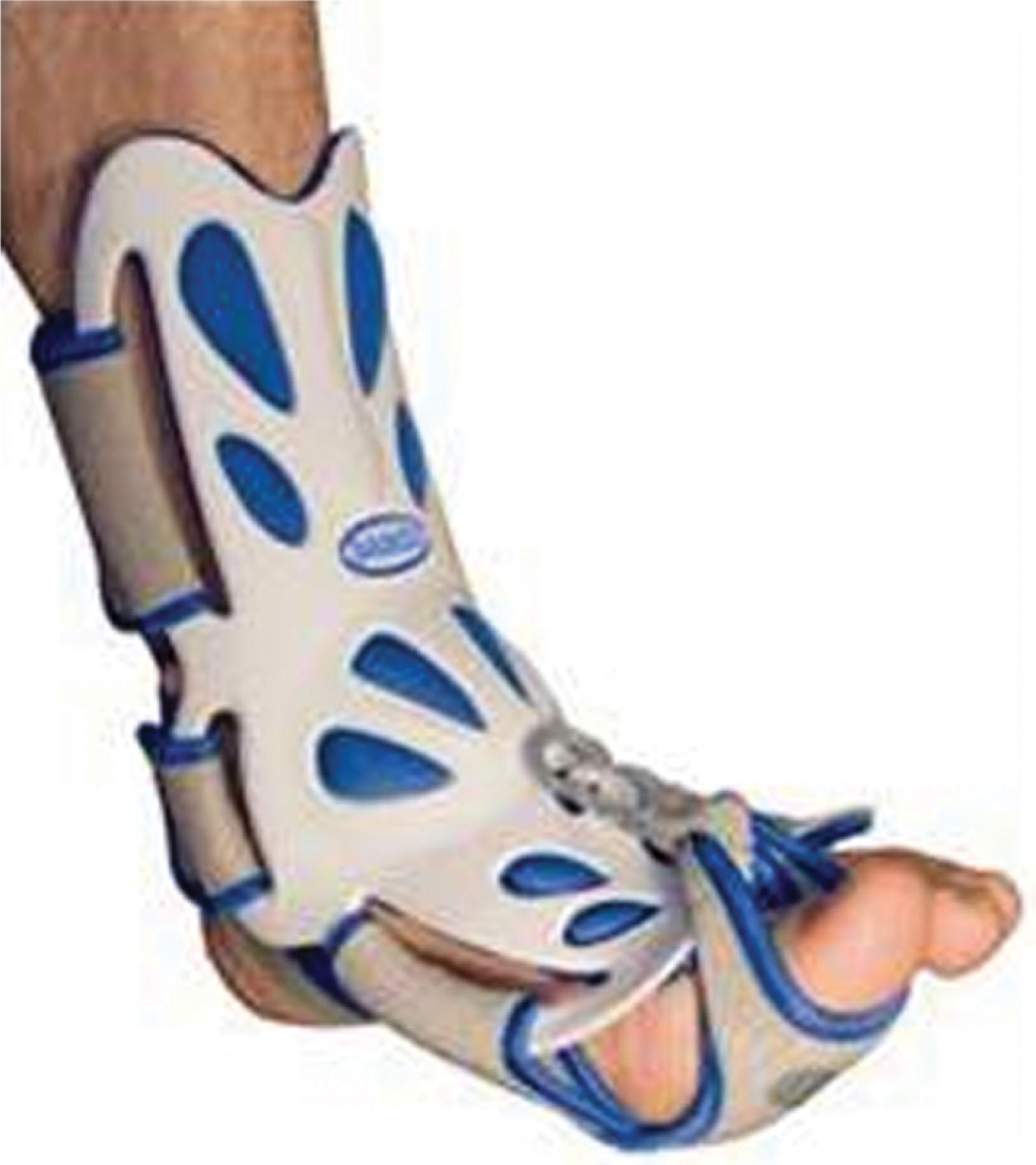
Become a Clinical Tree membership for Full access and enjoy Unlimited articles
If you are a member. Log in here